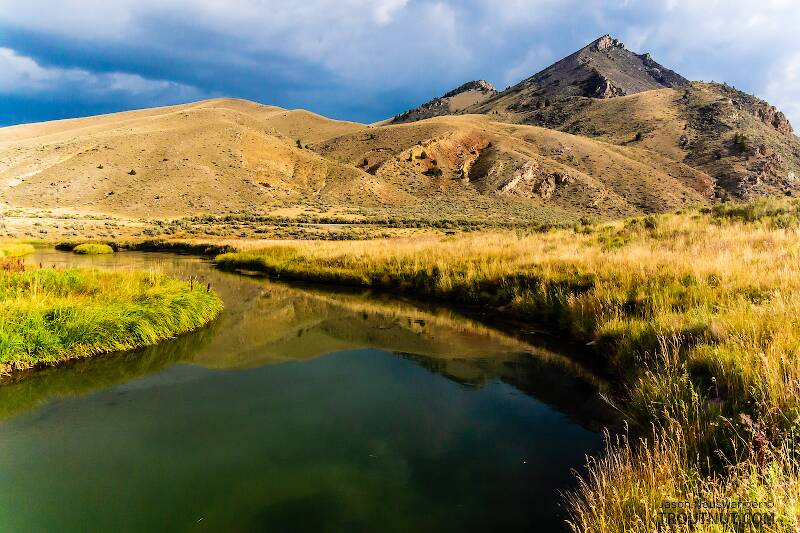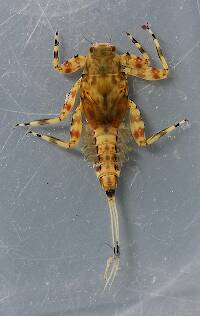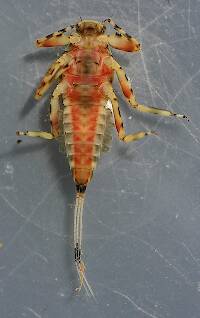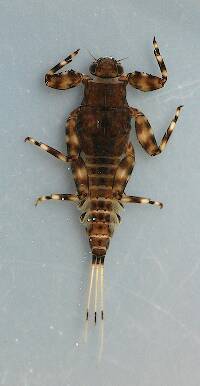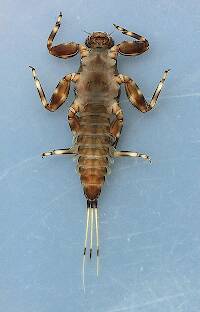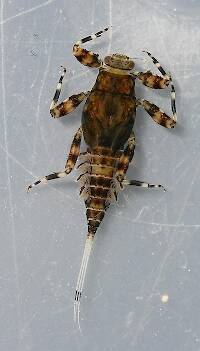
Salmonflies
Pteronarcys californica
The giant Salmonflies of the Western mountains are legendary for their proclivity to elicit consistent dry-fly action and ferocious strikes.
Featured on the forum

This specimen keys pretty easily to Onocosmoecus, and it closely resembles a specimen from Alaska which caddis expert Dave Ruiter recognized as this genus. As with that specimen, the only species in the genus documented in this area is Onocosmoecus unicolor, but Dave suggested for that specimen that there might be multiple not-yet-distinguished species under the unicolor umbrella and it would be best to stick with the genus-level ID. I'm doing the same for this one.

Troutnut is a project started in 2003 by salmonid ecologist Jason "Troutnut" Neuswanger to help anglers and
fly tyers unabashedly embrace the entomological side of the sport. Learn more about Troutnut or
support the project for an enhanced experience here.
Lastchance on Jul 4, 2009July 4th, 2009, 2:08 pm EDT
What is the FLAV mayfly that I'll be fishing out West in August? I'm not sure what to tie, what colors they are or what size. Anyone have a parachute or sparkle dun pattern?
Thanks,
Bruce
Thanks,
Bruce
GONZO on Jul 4, 2009July 4th, 2009, 3:35 pm EDT
Bruce,
Drunella flavilinea (Ephemerella flavilinea in older texts) is a medium-size Western ephemerellid species, aka Small Western Green Drake or Slate-Winged Olive. You can find photos, info, and (if you'll click on the pattern names at the bottom of the page) some patterns to try here:
http://www.westfly.com/entomology/mayfly/flav.shtml
(Please note that you'll have to adjust the colors of the patterns--which are really tying style suggestions--to the colors indicated for the flavs. Emergers or freshly emerged duns will have lighter body colors.)
Drunella flavilinea (Ephemerella flavilinea in older texts) is a medium-size Western ephemerellid species, aka Small Western Green Drake or Slate-Winged Olive. You can find photos, info, and (if you'll click on the pattern names at the bottom of the page) some patterns to try here:
http://www.westfly.com/entomology/mayfly/flav.shtml
(Please note that you'll have to adjust the colors of the patterns--which are really tying style suggestions--to the colors indicated for the flavs. Emergers or freshly emerged duns will have lighter body colors.)
Taxon on Jul 4, 2009July 4th, 2009, 3:38 pm EDT
Bruce-
The mayflies are Drunella flavilinea and D. coloradensis, which are said to be so similar that even entomologists have trouble telling them apart. Commonly referred to as either Flavs or Lesser Green Drakes, there is a sufficient amount to say about them, that Western Mayfly Hatches by Hafele and Hughes devotes a separate chapter (15 pages) to them. My recommendation would be to simply order the book, as in my opinion, it is (by far) the best book available for western mayflies.
The mayflies are Drunella flavilinea and D. coloradensis, which are said to be so similar that even entomologists have trouble telling them apart. Commonly referred to as either Flavs or Lesser Green Drakes, there is a sufficient amount to say about them, that Western Mayfly Hatches by Hafele and Hughes devotes a separate chapter (15 pages) to them. My recommendation would be to simply order the book, as in my opinion, it is (by far) the best book available for western mayflies.
GONZO on Jul 4, 2009July 4th, 2009, 3:54 pm EDT
Ha! Happy 4th, Roger...and the same to all my fellow Troutnuts! :)
Taxon on Jul 4, 2009July 4th, 2009, 4:00 pm EDT
Ah, now I get it, looks like we were keying at the same time. A happy 4th to you too, Lloyd.
Lastchance on Jul 6, 2009July 6th, 2009, 3:22 pm EDT
Thanks: I guess I should have known. I never heard of them until this trip out West became a reality. I looked on the site but I couldn't locate them, but I'm sure I must have looked in the wrong place.
Bruce
Bruce
Doublespey
Posts: 61
Posts: 61
Doublespey on Jan 17, 2012January 17th, 2012, 9:38 am EST
I've fished them on the Henry's Fork below Ashton, They generally come off in the lower light, late afternoon, BUT, some mid-afernoon rain clouds can bring on a great hatch. A #14 Parachute olive body works well along with the same body comparadun. I did well one day with no flavs with me, and a sudden rainfall, and flavs and fish were everywhere. I did well on a Parachute Adams size #14. Sizes are #14-16 and a brown shuck and olive bodied Comparadun is a great pattern. Hot, warm day in July and it will be 8 PM, or later before they come off. Fish luv'um, and generally aren't that picky when flavs come off.
Quick Reply
Related Discussions
Topic
Replies
Last Reply
10
Sep 3, 2014
by PaulRoberts
by PaulRoberts
9
Jul 22, 2014
by Crepuscular
by Crepuscular

